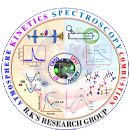The rate coefficients of ((E)-CF3CH═CHF, (Z)-CF3CH═CHF, (E)-CF3CF═CHF, and (Z)-CF3CF═CHF) + OH reactions were computed using M06-2X/6-31+G(d,p) theory in the temperature range of 200 and 400 K. The possible reaction mechanisms of the ((E)-CF3CH═CHF, (Z)-CF3CH═CHF, (E)-CF3CF═CHF, and (Z)-CF3CF═CHF) + OH reactions were examined. The rate coefficients for the addition and abstraction reactions were calculated using canonical variational transition state theory (CVT) and conventional transition state theory (CTST), respectively, and we concluded that abstraction reactions are negligible within the temperature range and addition reactions take the lead role. The small curvature tunnelling (SCT) was included in the computation of the rate coefficients. The temperature dependent rate expressions (in cm3 molecule–1 s–1) of the (E)-CF3CH═CHF, (Z)-CF3CH═CHF, (E)-CF3CF═CHF, and (Z)-CF3CF═CHF + OH reactions between 200 and 400 K are presented. The atmospheric lifetimes and global warming potentials (GWPs) of the test molecules were computed using the rate coefficients obtained in this study, and it is concluded that these molecules are very short-lived in the Earth’s atmosphere with low GWPs.
-
Call
-
E-mail
Journal Details
1. Rate Coefficients and Reaction Mechanism for the Reaction of OH Radicals with (E)-CF3CH═CHF, (Z)-CF3CH═CHF, (E)-CF3CF═CHF, and (Z)-CF3CF═CHF between 200 and 400 K: Hybrid Density Functional Theory and Canonical Variational Transition State Theory Calculations..
Balaganesh M., Rajakumar B J. Phys. Chem. A, , 9835-42, 40
